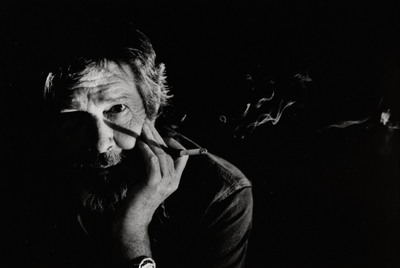U-M Institute for the Humanities revisits John Cage's 'Lecture on the Weather'

John Cage
photo courtesy of the Institute for the Humanities
The extraordinary, inspired exhibit “John Cage: Lecture on the Weather” at the University of Michigan Institute for the Humanities is a meditative cacophony.
Cage — composer, music theorist, poet, and ultimately, philosopher — was one of America’s seminal 20th century talents. Influential through his lifelong association with dancer Merce Cunningham, Cage’s arguably most significant contribution to American music was his development in the late 1940s of what he called “aleatoric” (or “chance controlled”) music.
The idea, fully realized in “Lecture on the Weather,” is to harness sound by setting it free from the composer’s or performer’s control.
The most influential (and controversial) example of this kind of music is his 1952 “four minutes, thirty-three seconds,” in which the score instructs the performer not to play though the work’s duration as the auditorium’s ambience creates an unrepeatable soundscape.
From this impenetrable minimalist tactic to the use of compositional repetition and prepared instruments, Cage challenged the very nature of music.
His “Lecture on the Weather” uses 12 speaker-vocalists (Cage’s specific instructions call for “preferably American men who have become Canadian citizens”) with each vocalist using his or her own sound system to distinguish each voice from the others. Add a 10-minute introduction — where Cage expounds on his political, social, philosophical, and environmental concerns — and the soundscape runs approximately 46 minutes.
But this period is merely one dimension of “Lecture on the Weather.” As Amanda Krugliak, arts curator at the Institute for the Humanities, says in her gallery statement, “Cage spoke of time as (being) horizontal rather than vertical, ‘The past is not a fact but simply a big field that has a great deal of activity in it.’”
The current exhibit is an installation adaptation of Cage’s multimedia performance work commissioned in 1975 by the Canadian Broadcasting Corporation for the then-upcoming United States bicentennial. Among the adaptations for this installation are five sound speakers; a soundboard and wall mounted projection unit; four Klieg lights facing each of the gallery’s walls; and a wall clock frozen precisely at 4:33.
Cage’s original voiced introduction serves as an orientation to the composition as well as a social critique of contemporary American society. The voices of the vocalists (or, as calls them, “instrumentalists”) then meld and diverge for a little over a half-hour through the reading of texts by Henry David Thoreau. Accompanying the voices are recordings of a breeze, rain and thunderstorm.
This aspect of the installation is well worth experiencing, but the installation’s full impact will be missed unless the participant is patient enough to sit through the longer part of the vocalization — because after about two-thirds of the performance, the lights in the gallery begin to dim. Shortly, the gallery becomes dark with a series of Thoreau line drawings flashing intermittently on a wall through the narrative’s balance.
The result is a multidimensional immersion that is not only conceptually challenging as a work of art, but quite memorable as an experience. Sitting in the dark with these monochromatic drawings — some geometric, others biomorphic — while listening to the intermittent sounds of nature in counterpoint to the human voice, creates an experience both concrete and ethereal.
Daniel Herwitz, director of the Institute for the Humanities, writes in his personal statement that the institute chose to mount Cage’s “Lecture on the Weather” because it’s “the clearest example of Cage’s utopian desire to free the mind to think and accept otherness, be it in sound, in text, or in nature and people.
“This bicentennial address to America,” continues Herwitz, “at its great moment of self-adulating nationalism, says nothing is more American than the retreat from the America of the city, the monument, the fireworks, the bulkhead, the settler claim of sovereignty over land and native, the politics of Cold War, (and) domination, to a place a few miles lateral where through experiment life can be experienced otherwise and thinking can become new.”
It only requires a little patience and perseverance for Cage’s “Lecture on the Weather” to free its participants anew.
“John Cage: Lecture on the Weather” will continue through Nov. 5at the University of Michigan Institute for the Humanities’ Exhibition Space, Room 1010, 202 South Thayer Street. Gallery hours are 9 a.m. to 5 p.m., Monday-Friday. For information, call 734-936-3518.
John Carlos Cantú is a free-lance writer who reviews art for AnnArbor.com.


Comments
Kim Kunoff
Tue, Oct 19, 2010 : 8:36 p.m.
This hidden gem within UM holds some of the most provocative exhibits, thanks to curator Amanda Krugliak and Humanities Institute Director Daniel Herwitz. I would call it one of Ann Arbor's hidden avant-garde secrets.